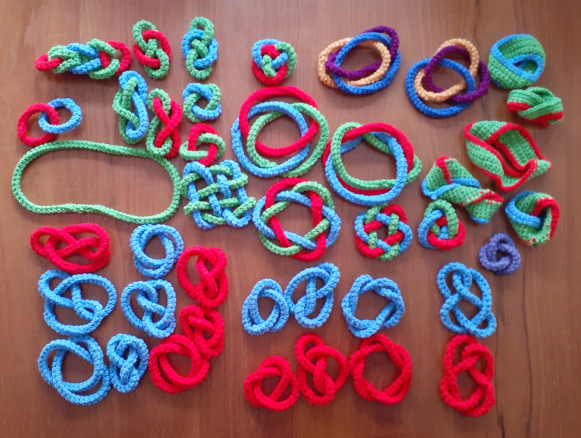The Problem with Two Girls
Puzzle. Two girls were born to the same mother, at the same time, on the same day, in the same month, in the same year, and yet somehow they’re not twins. Why not?
I won’t tell you the expected answer, but my students are inventive. They suggested all sorts of scenarios.
Scenario 1. There are two different fathers. I had to google this and discovered that, indeed, it is possible. This phenomenon is called heteropaternal superfecundation. It happens when two of a woman’s eggs are fertilized by sperm from two different men. Unfortunately for my students, such babies would still be called twins.
Scenario 2. The girls are born on the same date, but not on the same day. This could happen when transitioning from the Julian to Gregorian calendar. The difference in birth times could be up to two weeks. I had to google this and discovered that twins can be born months apart. The record holders have a condition called uterus didelphys, which means that the mother has two wombs. Unfortunately for my students, such babies would still be called twins.
Scenario 3. The second girl is a clone. This scenario can potentially happen in the future. Fortunately for that student, I suspect that such babies would be called clones, not twins.
I decided to invent my own scenario outside of the actual answer, and I did.
Scenario 4. Two girls are from the same surrogate mother, but they are not twins. I had to google this and discovered that this actually happened: Surrogate mother of ‘twins’ finds one is hers.
Sometimes life is more interesting than math puzzles.
Share:Martin Gardner’s Surprise
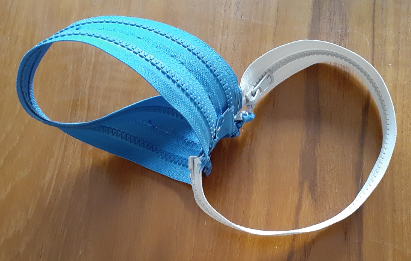
In his article on Möbius strips, Martin Gardner included a cute construction.
Construction. Cut out a cross from a piece of paper. Then glue one pair of opposite ends to make a cylinder and the other pair to make a Möbius strip. Then Martin instructs, “Trisect the twisted band, then bisect the untwisted one, and open up for a big surprise!”
In my effort to reuse Möbius strips, I started making them out of zippers. So Martin’s construction had its destiny zipped. The first picture shows the construction before it is being dissected. I was quite happy with my plan to use zippers as it had its advantages over paper. For the surprise to work, the twisted band shouldn’t be cut completely. Meaning, the middle part of the Möbius strip shouldn’t be cut. I sewed my zipper monstrosity not to cause any ambiguities: there is nothing to cut, just unzip the zippers.
Little did I know that unzipping is not the issue, but zipping back up is. I tried to zip the surprise back up several times; all of them unsuccessfully, as you can see on the two other pictures. I finally had to invite the real expert — my grandson — to do it.
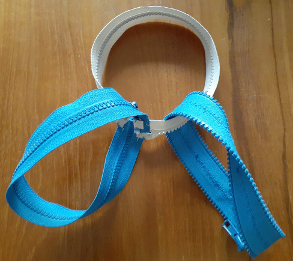

Share:
Seven, Ace, Queen, Two, Eight, Three, Jack, Four, Nine, Five, King, Six, Ten
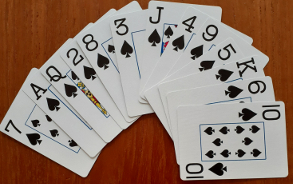
To prepare for this magic trick, take all the spades out of a deck and place them in the following order: seven, ace, queen, two, eight, three, jack, four, nine, five, king, six, and ten. Turn the assembled deck face down, so that the seven is on top. Now you are ready to do the trick.
Magic trick. Transfer the top card to the bottom of your deck and deal the new top card face-up on the table. Repeat this process until all the cards are dealt. And — abracadabra — the cards are dealt in order.
I showed this trick to my grandchildren, and they decided to reproduce it. They tried to calculate where each card goes, without too much success. Then my son showed them another trick: how to arrange the cards without calculation. He started building his arranged deck from the end of the trick with all the cards in order face-up on the table with the king on top. He took the king and put it face-down into his hand. Then he repeated the following procedure until all the cards were in his hand: He took the next card from the table and put it face-down on top of the one in his hand. Then he moved the card from the bottom of his deck to the top. And — abracadabra — the cards are arranged correctly for the trick.
Next time, I should ask my grandkids to show this trick with the whole deck.

Share:
Zipper Math
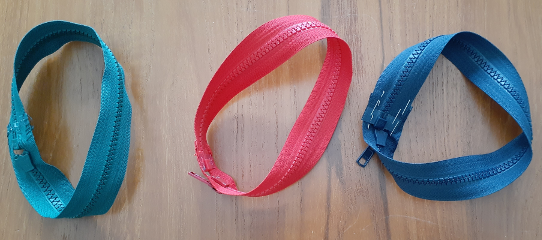
Each time I teach my students about the Möbius strip, I bring paper, scissors, and tape to class. The students make Möbius strips, and then I ask them to cut the strips in half along the midline and predict the result.
Then we move to advanced strips. To glue the Möbius strip, you need one turn of the paper. An interesting experiment is to glue strips with two, three, or more turns. In this case, too, it is fun to cut them along the midline and predict the shape of the resulting thingy. My class ends with a big paper mess.
As you might know, I am passionate about recycling. So I have always wanted to buy Möbius strips that can be cut in half and then put back together. I didn’t find them, so I made them myself from zippers. Now I can unzip them along the midline and zip them back together. I hope to have less mess in my future classes. We’ll see.
Share:Meta Solving a Probability Puzzle
I recently posted my new favorite probability puzzle from the fall 2019 issue of Emissary, submitted by Peter Winkler.
Puzzle. Alice and Bob each have a biased coin that flips heads with probability 51% and 100 dollars to play with. The buzzer rings, and Alice and Bob begin flipping their coins once per minute and betting one dollar on each flip against the house. The bet is at even odds: each round, each of them either loses or wins a dollar. Alice always bets on heads, and poor Bob, always on tails. As it happens, however, both eventually go broke. Who is more likely to have gone broke first?
Follow-up question: They play the same game as above, but this time Alice and Bob are flipping the same coin (biased 51% toward heads). Again, assuming both eventually go broke, who is more likely to have lost their money first?
One might assume that Bob obviously got a bad deal. He will lose his money very fast. So the answer to both questions must be that Bob loses his money first. If you know me, you should realize that I wouldn’t have given you this puzzle if the answer was that intuitive. I love counter-intuitive puzzles.
Bob has a disadvantage, so he is guaranteed to lose eventually. Alice has an advantage, so she might lose, or she might not. If she goes broke, that means there should be more tails in the flips than if she doesn’t go broke. How does this influence the second scenario, in which they use the same coin? As we are expecting a lot of tails in the flips, the situation should be better for Bob as compared to the first scenario. Given that I posed this puzzle, one might decide that in the follow-up question Bob doesn’t go broke first. Is it a tie?
But, if Bob is the first to go broke in the first scenario, why would I include the first part of the puzzle at all? If you know me, you should wonder what makes the first question interesting. Or maybe, you know Peter Winkler, in which case you should also wonder the same thing.
I gave you enough meta information to guess the amazing counter-intuitive answers to these two questions: in the first scenario, they tie; and in the second scenario, Alice goes broke first with higher probability.
To prove that they tie in the first scenario, let me first define a switch on a sequence of coin flips. A switch changes each head into tails and vice versa. The switch creates a one-to-one correspondence between the sequences of flips where Bob goes broke with the sequences where Alice goes broke. Suppose p is the probability that Alice goes broke with a particular sequence a, and q is the probability that Bob goes broke with a `switched’ sequence b. Then p = rq, where r = (49/51)200. The reason is that sequence a has exactly 200 more tails than sequence b. The same ratio r works for any pair of switched sequences. Bob is guaranteed to go broke eventually. But to calculate the conditional probability of Alice going broke with sequence a, given that she does go broke, we need to divide the probability of the sequence a occurring by the probability that Alice goes broke. The resulting probability distribution on sequences of length n has to be the same as for Bob because it has to sum to one. If Alice goes broke, then the probability that she goes broke after n flips is the same as for Bob. That means they tie.
To answer the second question, we use the switch again. The switch creates a one-to-one correspondence between sequences of flips where Alice goes broke first and Bob second, and vice versa. The sequence for which Alice loses second has 200 more tails than the corresponding sequence where Bob loses second. Thus, in each pair of two switched sequences, the probability of the sequence where Alice loses second is equal to r times the probability of the sequence where Bob loses second. Thus, the probability of Alice winning is r times the probability of Bob winning, and r is a very small number.
Share:
Borromean Rings
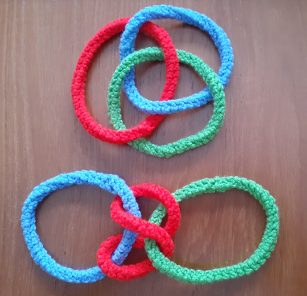
Here are my newly-made Borromean rings: two identical sets of them. They are an example of three linked rings, with any two of them not linked. The top set is positioned the way the Borromean rings are usually presented. You can see that any two rings are not linked by mentally ignoring the third one. For example, the red ring is on top of the green one, the green one is on top of the blue one, and the blue one is on top of the red one. They have a non-transitive ordering.
The bottom set of rings is arranged for a lazier thinker. Obviously, the blue and green rings are not linked.
Share:
My Moscow State University Transcripts
I used to be proud of my Russian math education. I am still proud of my high school one, but not so much of the one I received in college. In Soviet Russia, a student had to choose their major before applying to college. I wanted to study mathematics, and I got accepted to the best place for it in Soviet Russia: mekhmat — the math school at the Moscow State University. I used to be proud of my education there, but now I have my doubts.
I had to take, on average, four math classes per semester for five years, which totals about 40 math classes. Woo hoo! I don’t think American students could even choose to take that many. This was presumably good, but most of the courses were required, and their curriculum remained unchanged for many, many years. Obviously, the system was very rigid. The faculty members feared retaliation from the communist party and forgot how to take initiative. The bureaucracy prevented the department from adding new and exciting math to the outdated curriculum.
This post is not about my grades but about the actual subjects that we were taught then. But, in case anyone is wondering, my only B was in English; everything else was straight As.
Some of the classes listed below lasted two or more semesters, that’s why they do not sum up to the promised 40. Unfortunately, I do not remember which ones. These were the required math classes:
- Analysis
- Analytical Geometry
- Advanced Algebra
- Theoretical Mechanics
- Linear Algebra and Geometry
- Differential Equations
- Partial Differential Equations
- Functions of Complex Variables
- Probability and Statistics
- Differential Geometry and Topology
- Numerical Methods
- Introduction to Mathematical Logic
- Control Theory
- Analysis III
- Computer Science and Programming
- Programming Practice
- Physics
- History and Methodology of Mathematics
- Thesis Work
An impressive list? But guess what — I remember nothing from most of these classes. As an exception, I remember bits of Differential Equations, taught by Vladimir Arnold, a charismatic teacher. I remember Linear Algebra well, not because of my Linear Algebra class, but because I read Gelfand’s book on the subject and loved it. I remember that the Differential Geometry and Topology class was taught by Fomenko with great pictures and boring material. By the time I took Fomenko’s class, I already knew topology from an unofficial class taught by Dmitry Fuchs, which was so much better. In fact, in order to learn what I wanted, I had to take many classes unofficially, so my total is actually way above 40.
By junior year, we were finally allowed to choose some classes which would count towards our transcripts, and this is what I picked.
- Infinite-Dimensional Representations of Lie Groups
- Theory of Functions of Many Complex Variables
- Representations of Lie Groups
- Discrete Mathematics
I remember these classes much more vividly. I also wrote a graduate thesis: “Models of Representations of Generalized Clifford Algebras.” I loved working on that paper.
We had non-math classes too: everyone had to take them.
- History of the Communist Party of the USSR
- Philosophy of Marxism-Leninism
- Political Economy
- Scientific Communism
- Foundations of Scientific Atheism
- Soviet Law
- Foreign Language (English)
- Physical Education
- Foundations of Marx-Lenin’s Aesthetics
To graduate, everyone had to pass two state exams: Mathematics and Scientific Communism. Whatever the latter might mean.
Did I mention that I am no longer proud of my former Soviet college education? What a colossal waste of time!
Share:
A Card-Dealing-Trick Sequence: Persistimis Possessiamo
Pete McCabe presented his trick, Persistimis Possessiamo, at the Gathering for Gardner in 2018.
Trick. Pete asked for two volunteers, let’s call them Alice and Bob. Bob took out his favorite card, the Queen of Spades, from the deck and put it back following Pete’s instructions. Then Alice dealt the deck alternatively into two piles, Bob’s and hers, starting with Bob’s. Alice took her pile and repeated the same process several times until only one card was left. And, abracadabra: it was Bob’s chosen Queen of Spades.
Pete McCabe is interested in scripting magic. In his blog post, Scripting Magic for Zoom, he describes ways to make sure that Bob inserts his card into the 22nd place without using sleight of hand, but rather using a theatrical script which makes the process magical rather than mathematical. The magic part is related to the fact that the number of letters in the trick title, Persistimis Possessiamo, is 22. As a result, he can do the trick on Zoom without ever touching the cards.
Once a magician knows how to manipulate the volunteer to insert the card into a specific place in the deck, the trick becomes deterministic and works on any-sized deck, as long as the magician can calculate where the card goes. We will now perform this calculation.
We denote our card-inserting sequence as a(n), where n is the size of the deck, and a(n) is the place where the card is inserted. For starters, a(2n+1) = a(2n): when the size of the deck is odd, the last card during the first deal goes to Bob, and doesn’t effect the other deals. Now, we obviously have a recursion. First, we observe that in order to end up in Alice’s pile after the first deal, Bob’s chosen card should occupy an even-numbered place. Suppose we start with 2n cards. After the first deal, Bob’s chosen card is in the place number a(2n)/2 from the bottom in Alice’s pile. That means, the card is in the place number n + 1 − a(2n)/2 from the top. This gives us an equation: a(n) = n + 1 − a(2n)/2, which is equivalent to a recursion: a(2n) = 2(n + 1 − a(n)).
Given that each element of the sequence a(n) is doubled, we are only interested in even-indexed values. Consider b(n) = a(2n) = a(2n+1). Then b(1) = 2, and the recursion for b is b(n) = 2(n + 1 − b⌊n/2⌋).
From here, we get the sequence, which is now sequence A350652 in the OEIS:
2, 2, 4, 6, 8, 6, 8, 6, 8, 6, 8, 14, 16, 14, 16, 22, 24, 22, 24, 30, 32, 30, 32, 22, 24, 22, 24, … .
Share: